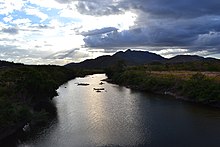Cotingo River
| Cotingo River | |
|---|---|

Cotingo River, São Marcos indigenous reserve
|
|
| Native name | Rio Cotingo |
| Country | Brazil |
| Physical characteristics | |
| Main source | Roraima state |
| River mouth |
Surumu River, Pacaraima, Roraima 3°54′42″N 60°30′04″W / 3.911686°N 60.501107°WCoordinates: 3°54′42″N 60°30′04″W / 3.911686°N 60.501107°W |
The Cotingo River (Portuguese: Rio Cotingo) is a river of Roraima state in northern Brazil, a tributary of the Surumu River. It flows through the Raposa Serra do Sol indigenous territory. For many years there has been discussion over building a major hydroelectric power project on the river.
The Cotingo River has its headwaters at the foot of Mount Roraima in the Guayana Highlands region. The upper part of the Cotingo River basin is contained in the 116,748 hectares (288,490 acres) Monte Roraima National Park, a protected area created in 1989 that is fully contained in the Raposa Serra do Sol indigenous territory.
The river runs for about 210 kilometres (130 mi) to its confluence with the Surumu River, of which is the main tributary.
It contains continuous stretches of rapids and waterfalls. The savanna region of the river basin has an equatorial climate with tropical monsoon rainfall.
It is home to the Sun parakeet (Aratinga solstitialis), Rio Branco antbird (Cercomacra carbonaria), Finsch's euphonia (Euphonia finschi), Bearded tachuri (Polystictus pectoralis) and Hoary-throated spinetail (Synallaxis kollari).
The river basin has high potential for mining, agriculture, ranching, and ecotourism, and as a result there is tension between the strong Indian population and the ranchers and settlers.
Plans have been made for a hydro-electric project on the river. The first studies of the hydroelectric project were made in the 1970s. The proposed hydroelectric project would involve building five dams along the length of the river.
In 2006 the federal senate approved a legislative decree aimed to authorise the work, which would be undertaken in an indigenous area and would affect the Ingarikó, Makuxi, Patamona, Taurepang and Wapixana people.
...
Wikipedia

